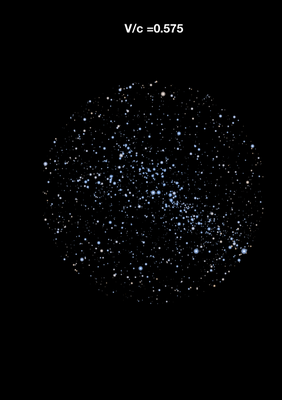The future interstellar flight GPS: a world "premiere" towards travelling to the stars

For André FÜZFA, astrophysicist and professor at the department of mathematics, if only one physical problem was to mention, it would be interstellar travel.
In an open-access article published in the prestigious journal Physical Review, he details how to model any interstellar voyage, from its precise trajectory to the stellar panoramas the astronaut will have to use to navigate. The model is based on Einstein’s general relativity to take into account the acceleration effects at velocities near the speed of light and involves no speculative physics.
This discovery is a world “premiere” which could revive the current ambitions about interstellar travel. “But, be careful, the environmental footprint will be huge”, warns André Füzfa.
Science fiction?
While people think it is just a science-fiction matter, interstellar travel also fascinates scientists. André FÜZFA, astrophysicist and mathematician at the UNamur has modelled it carefully. His research has just succeeded and now enables the precise calculation of a spaceship’s accelerated trajectory, energy cost and mass evolution, the effective voyage time and light distortions noticed on board or coming from the vessel.
It is the first time that such a precise and complete model of interstellar flight is elaborated. This tool sets the basis for future navigation systems, a sufficiently reliable GPS to travel without getting lost in outer space.
This model is immediately applicable to ongoing projects like Starshot, which aims at sending thousands of one-gram space probes by directed energy propulsion towards Alpha Centauri, the stellar system closest to ours. André Füzfa’s model makes deep space travelling even closer.
15 times the annual world energy productioN
But the model also highlights the real interstellar travel problem. It is neither the amount of propellant, nor the duration of the trip but rather its tremendous energy cost. A manned 100 tons space mission to the closest star to earth would cost about 15 times the annual world energy production.
“It is often (naively?!) hoped that moving to other star systems will be our only escape if one day this planet becomes inhospitable. But actually, developing interstellar travel might well precipitate the exhaust of our planet resources. We can now pave the way for interstellar exploration (…) beyond the engineering sketches and theoretical exploratory works done so far. Hopefully, we will at last leave ourselves to this intimate experience common to all those who go out stargazing: the appeal of the stars.”, concludes André Füzfa in his article. But the author also asks : at which cost?
 |
 |
|
Left: sky map in the Alpha Centauri direction; Right: a stellar panorama aboard star ship travelling towards this star. The spaceship acceleration and speed combine to distort the sky and lose the unwise and unfortunate space traveller. |
|
Want to become an interstellar traveller? First, discover Prof. André Füzfa’s full article, published in open-access in Physical Review.
Help the University of Namur to make discover the stars: https://www.unamur.be/soutenir/observatoire/
More info
André FÜZFA | Email: andre.fuzfa@unamur.be | Tel: +32 (0)81 72 49 32
 |  |
|---|











